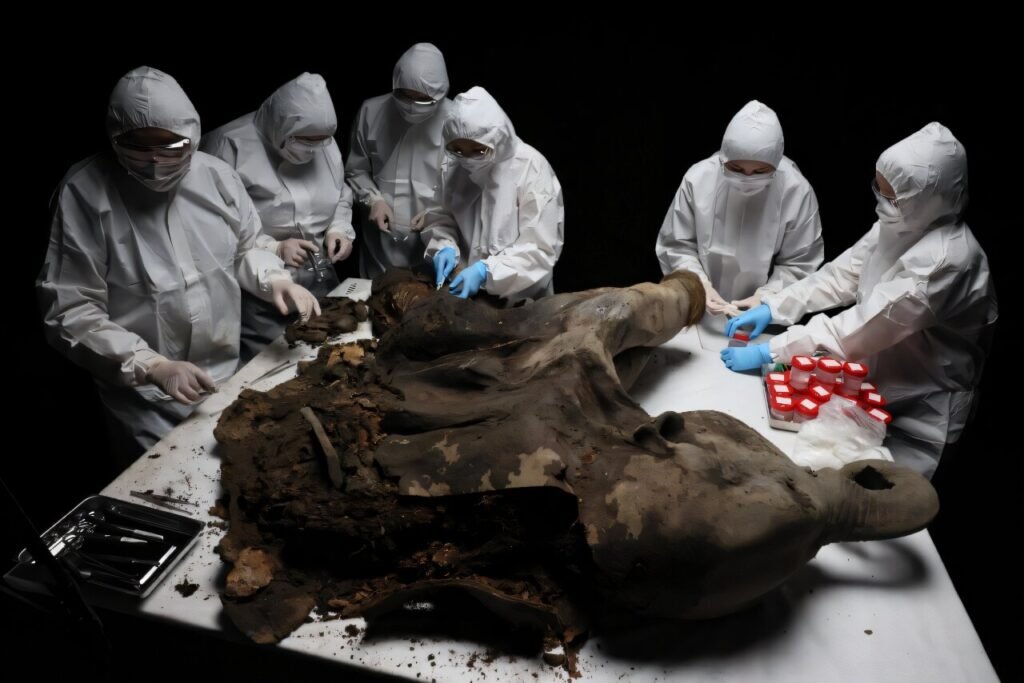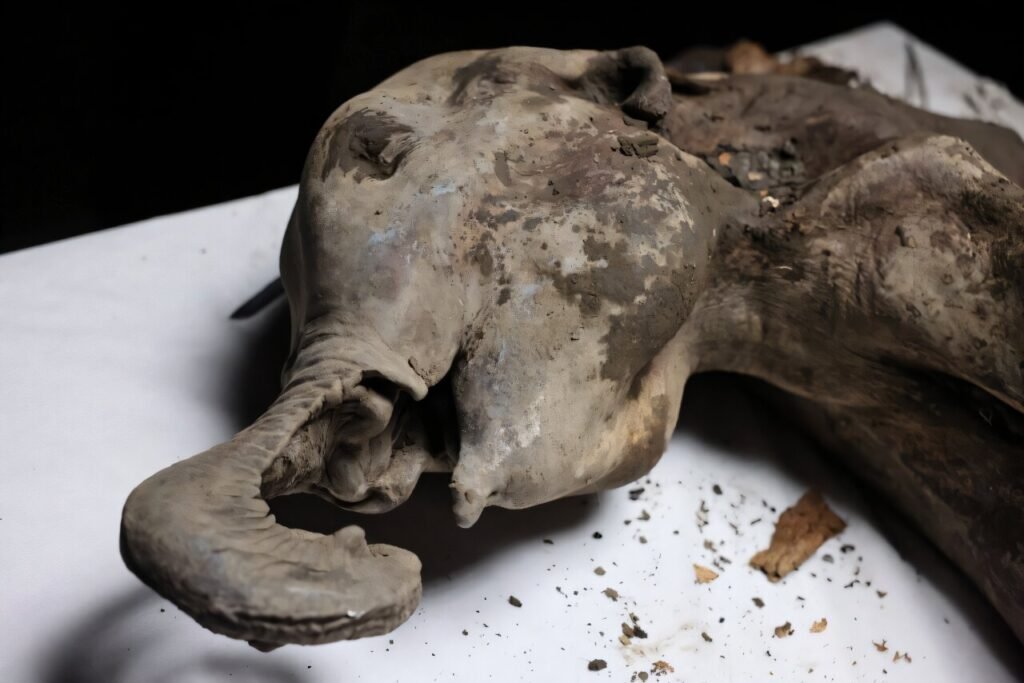In a sterile laboratory tucked deep in Russia’s far east, a team of scientists donning white bodysuits, goggles, and facemasks moved with surgical precision. Scalpels glinted under the lab lights as careful hands made incisions, not into a human body, but into something far older and far rarer—a woolly mammoth calf named Yana, whose life ended roughly 130,000 years ago.
Her remains were pulled from the icy grip of Siberian permafrost, astonishingly intact, her wrinkled grayish-brown skin still clinging to her muscular frame, tufts of reddish hair sprouting from her body, her eyes recognizable, and her small trunk curled toward her mouth. For the scientists working on her, this was no ordinary necropsy—it was an encounter with prehistory. And Yana wasn’t just any fossil. She was a time capsule of Ice Age Earth.
The Frozen Child of the Yana River
Yana’s discovery is a product of our warming world. As global temperatures rise and ancient permafrost begins to thaw, it reveals long-buried secrets. In Yana’s case, her body emerged from the river basin that shares her name—a vast expanse of northern Siberia where time has stood still in the ice.
She was first estimated to be around 50,000 years old, but subsequent analysis of the permafrost layer where she was found has pushed that number back dramatically. Yana, researchers now believe, died over 130,000 years ago—making her one of the oldest and most well-preserved mammoths ever discovered. And thanks to the deep freeze she rested in for over a hundred millennia, scientists now have access to soft tissues, internal organs, even the contents of her stomach.

Her remarkable preservation is not just a lucky break. It’s a consequence of the very process that may now threaten humanity—the thawing of ancient permafrost, triggered by climate change. Where once the frozen ground sealed off these remains, acting like a biological time vault, warming temperatures are now breaking those seals open.
A Mammoth Laboratory
At the Mammoth Museum in Yakutsk, a half-dozen scientists gathered in late March to perform what might be the world’s most extraordinary animal autopsy. With care and awe, they dissected Yana’s front quarters, the portion of her body that had broken free from a cliff. The rest—her hindquarters—remained frozen into the earth, waiting their turn.

Artemy Goncharov, head of the Laboratory of Functional Genomics and Proteomics of Microorganisms in Saint Petersburg, called it an “opportunity to look into the past of our planet.” And that’s no exaggeration. From ancient gut flora to intact DNA, every tissue sample from Yana could help reconstruct a piece of the Pleistocene puzzle.
The team has already retrieved preserved sections of the stomach and intestines—including a portion of the colon. These are not just anatomical features. They’re potential data sets. What did Yana eat? What plants existed then? What microorganisms called her body home? It’s a goldmine of information, and with modern genomic tools, researchers can now read that information like never before.
One particular area of interest? Her vagina. That’s right—scientists carefully worked to extract internal samples from the birth canal, hoping to identify the ancient microbiota that lived in her reproductive system. Why? Because microbial ecosystems tell a powerful story—about environment, diet, health, and even social behavior.
Milk Tusks and Mystery
At a glance, Yana resembles a modern elephant calf, and in some ways, that’s exactly what she was—a prehistoric cousin of our largest land mammals. She measured 1.2 meters (almost 4 feet) tall at the shoulder and stretched 2 meters long, weighing in at around 180 kilograms (about 400 pounds). Despite her solid build and thick skin, she died very young.

We know this because she had begun developing her “milk tusks,” the small, temporary tusks that both elephants and mammoths grow in early life—analogous to baby teeth in humans. The presence of these tusks told researchers she was likely older than a year when she died. But the cause of her death remains a mystery. Was it a predator? A fall? A sudden cold snap? We may never know.
One thing we can say for certain: humans didn’t do it. “There were no humans in Yakutia at the time she lived,” explained Maxim Cheprasov, director of the Mammoth Museum. “They didn’t appear in Siberia until between 28,000 and 32,000 years ago.” That’s a gap of over 100,000 years. Yana lived in a world untouched by human footprints, a time when mammoths roamed freely in herds across frozen tundras, and massive predators stalked the snow.
Ancient Pathogens: A New Threat?
But for all its scientific wonder, Yana’s unearthing also brings a sense of unease. As Goncharov explained, some of the research into her preserved tissues is meant to understand biological risks. That’s not just academic jargon—it’s a reference to the possibility that ancient pathogens, locked away in permafrost for millennia, could thaw and re-enter the biosphere.
It may sound like science fiction, but it’s a real concern. In recent years, anthrax spores released from melted permafrost in Siberia infected dozens of people and killed thousands of reindeer. Other dormant bacteria and viruses—possibly extinct or evolved in ways alien to modern immune systems—could lie in wait inside carcasses like Yana.
The team at Yakutsk is therefore also exploring microbial genomes, hunting for evidence of ancient pathogens. This is as much an exercise in biosecurity as it is in science. Could these ancient microbes adapt and infect modern organisms? Could they mutate? Could they spread?
No one knows for sure. But the answers could shape how we handle future finds—and the risks that come with them.
A Glimpse of Prehistoric Life
Despite the risks, there’s no denying that Yana offers a breathtaking window into a world long gone. Her stomach contents could reveal Ice Age plants. Her tissues could teach us about mammoth biology—how they grew, how they lived, how they adapted to the cold. Her DNA might even help in ongoing efforts to “resurrect” the species, through controversial de-extinction projects that hope to engineer mammoth-elephant hybrids capable of rewilding the tundra.
But perhaps the most profound value of Yana’s discovery lies in its ability to connect us to deep time. It’s one thing to imagine mammoths from skeletons or paintings. It’s another entirely to look into the face of a baby mammoth whose skin still bears the marks of life—its trunk curled mid-motion, its eyes eerily lifelike, its story waiting to be told.
More Than Just a Mammoth
Yana isn’t just an Ice Age relic—she’s a symbol. A symbol of the untold stories still buried beneath the Arctic tundra. A symbol of the accelerating pace of climate change, as the ancient ice gives up its secrets. A symbol of the delicate line between scientific discovery and ecological danger.
As the planet warms, more Yanas will emerge. Some may be mammoths, others woolly rhinos, cave lions, or prehistoric bison. Each one brings with it a potential wealth of knowledge—and a growing responsibility.
For now, Yana lies under the careful stewardship of scientists who are working not only to understand her, but to safeguard what she represents: a chance to learn, to prepare, and perhaps, to rethink our relationship with the world we are changing so rapidly.
She may have died 130,000 years ago, but Yana’s story is still unfolding—and it has never been more relevant.
